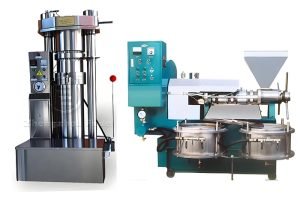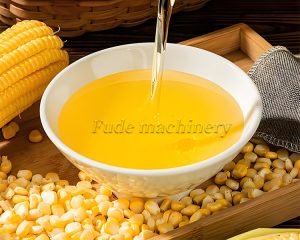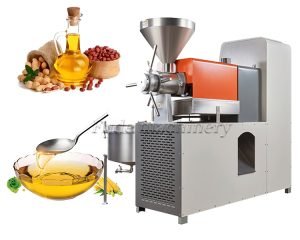What is the core work of a screw press?
A screw press uses a rotating screw inside a barrel to continuously squeeze oilseeds. This powerful mechanical pressure separates the liquid oil from the solid meal or cake.
The main job sounds simple: separate oil from solids. But a screw press does more. It’s a continuous solid-liquid separation machine. As the screw pushes material forward, it also creates friction. This friction generates heat, which can help “cook” the material slightly. This heating affects the final oil’s flavor and makes later processing easier. Our design goal is always to get the most oil out (low residual oil in the cake) while handling a good amount of material per hour. We also build them tough to last under constant pressure
The screw’s rotating spiral threads push material forward. Compression happens because the space available for the material gradually decreases along the screw’s length inside the press cage.
First, the screw worm acts like a conveyor. As it rotates, the spiral threads (called flights) catch the oilseeds falling from the hopper. They continuously push the material forward along the inside of the press cage. But just moving isn’t enough; it needs to squeeze. The real magic is how the screw design reduces the space for the material as it moves along.
As the screw pushes material into a progressively smaller space within the cage, internal pressure rises sharply. This high pressure forces oil out through the cage’s small gaps.
The process is gradual but powerful. As the screw worm pushes the oilseeds forward, the decreasing volume inside the press cage compacts them tightly. Air voids are eliminated, particles are forced closer, and the internal pressure starts to climb rapidly. This pressure isn’t uniform; it builds progressively along the length of the screw shaft. The highest pressure occurs in a specific zone near the end of the screw, just before the cake outlet. Here, the screw design provides the maximum compression ratio.

How Do Oil and Cake Leave the Machine Separately?
So the oil is squeezed out and the solids are left. How do they physically exit the machine without mixing again? Let’s trace their paths.
Oil seeps through the gaps in the press cage wall, flows down, and collects in a pan at the bottom. The remaining solid cake is forced out through an adjustable opening at the end of the cage.
The separation happens right at the press cage wall. The high pressure inside forces the liquid crude oil (which contains some very fine solid particles) through the narrow slits between the press bars. This oil then flows down the outside of the cage, often guided by channels or shields. It gathers in a collection tray or pan located beneath the press cage assembly. From this pan, an outlet pipe directs the collected crude oil away from the machine for storage or further processing (like filtering).
Meanwhile, the solid material, now with most of its oil removed, continues its journey inside the cage. The rotating screw keeps pushing it towards the end. At the very end of the cage is the cake outlet. The compressed solids are forced against the resistance set by the outlet adjustment mechanism (like the cone or plate). Eventually, the pressure is enough to push the solids through this opening. The expelled material is known as oil cake or meal. It typically comes out in the form of broken flakes, strips, or chunks, depending on the oilseed and the outlet setting. Observing the cake’s condition (thickness, dryness, how well it holds together) gives experienced operators valuable clues about whether the press is running optimally.
What Affects Screw Press Efficiency and Oil Yield?
Want to get the most oil out of your seeds? Need your press to run smoothly and last long? Several factors impact performance. Let’s review the most important ones.
Oilseed pre-treatment (especially moisture content and temperature), machine condition (wear), operating parameters (speed, outlet setting), and proper feeding heavily influence efficiency and yield.
Getting good results from a screw press isn’t just about the machine itself. How you prepare the oilseeds beforehand is absolutely critical.


Deeper Dive into Performance Factors
- Oilseed Pre-treatment: This is arguably the most crucial area.
- Moisture Content: Every oilseed has an ideal moisture level for pressing (often between 5-10%, but it varies). Too wet, and the material is too slippery or mushy, leading to poor oil release. Too dry, and the material is hard, causing excessive friction, high energy use, low yield, burnt cake, and rapid machine wear. Adjusting moisture correctly is vital.
- Temperature: Heating the seeds moderately before pressing (using a cooker or conditioner) makes the oil less viscous (flow better) and softens the seed structure, generally improving oil yield. This is typical for “hot pressing.” However, excessive heat damages oil quality.
- Cleanliness: Removing stones, sand, metal, and other debris is essential. Hard impurities cause severe wear and damage to the expensive screw worm and cage bars.
- Size Reduction: Some seeds like soybeans or cottonseed benefit from cracking or flaking before pressing. This breaks down cell walls and increases surface area, helping oil release.
- Machine Condition:
- Wear: As the screw worm and press cage bars wear down, the clearance between them increases. This reduces the pressure the machine can build, leading to a significant drop in oil yield. Regular inspection and timely replacement of worn parts are necessary maintenance.
- Cage Bar Gaps: If the gaps between bars get clogged with fines or widen due to wear, oil outflow is hindered or solids escape with the oil.
- Operational Settings:
- Screw Speed (RPM): Affects how long the material stays in the press and the throughput rate. Faster isn’t always better; it can reduce pressing time and increase friction heat excessively.
- Cake Outlet Setting: Directly controls the back-pressure inside the cage. Needs careful adjustment for each material.
- Feed Rate: Must be steady and match the machine’s capacity. Overfeeding causes jams; underfeeding wastes capacity.
Finding the best balance between high oil yield, energy consumption, wear rate, and preserving oil quality requires understanding these factors and adjusting them carefully. We provide guidance and equipment designed for optimal performance.

Deeper Dive into Heat Effects
This self-generated heat has both positive and negative consequences:
- Potential Positives:
- Reduced Viscosity: Heat makes oil thinner (less viscous). This allows it to flow more easily out of the seed structures and through the cage bar gaps, contributing to higher oil yield.
- Cell Structure Breakdown & Flavor: Moderate heat helps break down cell walls further, releasing more oil. For some seeds (like peanuts, sesame, rapeseed), this heat contributes to protein denaturation and chemical reactions (like the Maillard reaction) that develop desirable “roasted” or “nutty” flavors characteristic of traditional hot-pressed oils.
Since its establishment in 2015, Fude Machinery has been committed to providing high-quality and high-performance agricultural equipment solutions to customers worldwide. With advanced production technology, strict quality control, and continuous innovative R&D capabilities, we have gained praise from satisfied customers.
Related recommendations
-
What is the difference between hydraulic oil press and screw oil press
317Zhengzhou Fude Machinery integrates research and development, manufacturing, and sales, deeply understands customer needs, recommends and answers equipment questions for customers, teaches operation techniques, and produces oil presses, refiners, ...
View details -
The purpose of spiral oil press
259Spiral oil press is a common oil pressing equipment widely used in industries such as food, chemical, and pharmaceutical
View details -
How is Corn Oil Actually Produced?
4Dry vs. Wet Corn Germ Separation: Which Method is Right for You?Is Pre-treatment More Crucial than the Press for Corn Germ?Pressing vs. Solvent Extraction for Corn Germ: What's the Best Approach?Pre-Pressing + Solvent Extraction (The Standard)Why ...
View details -
How to buy screw oil press
10What is a screw oil press? How is it different from other oil presses?How does a screw oil press squeeze oil out of raw materials?Pressure Build-up in the BarrelOil Separation and Cake DischargeCold press and hot press screw oil presses, which is ...
View details
 Oil Press Equipment and Oil Refining Machinery for Sale – Start Your Oil Press Business
Oil Press Equipment and Oil Refining Machinery for Sale – Start Your Oil Press Business




HelloPlease log in